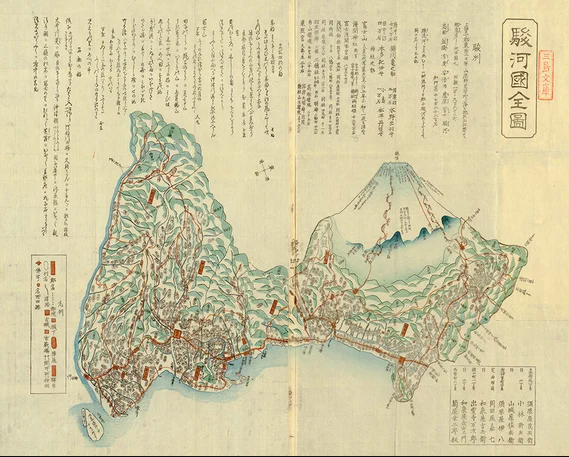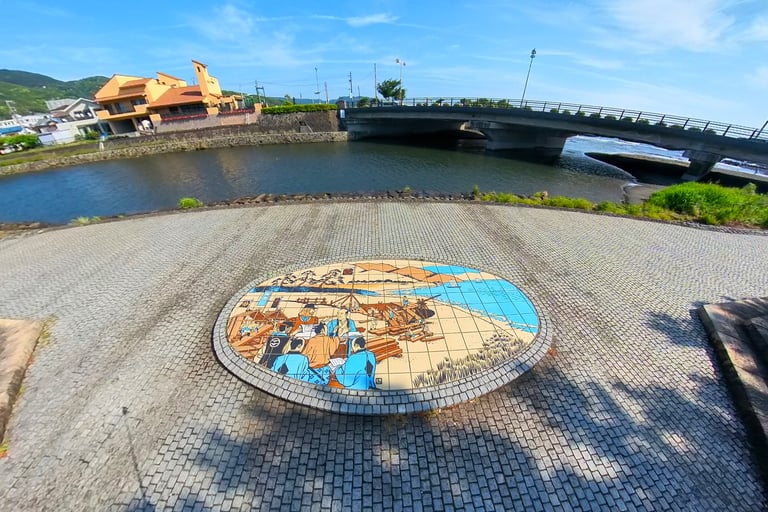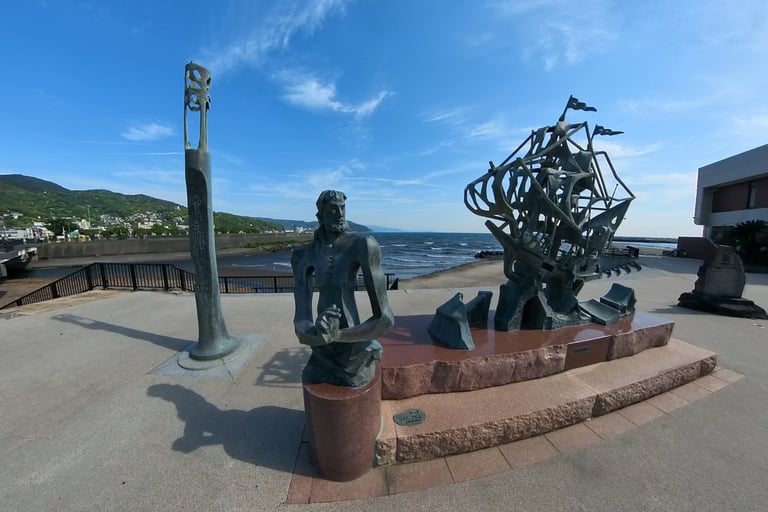TRACING WILLIAM ADAMS' FOOTSTEPS
Ito, Shizuoka Prefecture
Ito, in Shizuoka Prefecture, is a popular seaside onsen (hot spring) resort an easy train ride from Tokyo that lies at the northern end of the Izu Peninsula. William Adams was tasked by Tokugawa Ieyasu to build and commission Japan’s first galleons using western designs and shipwright skills. Success in this task was rewarded by Ieyasu bestowing on Adams Samurai hatamoto status. Adams' skills brought him closer into Ieyasu’s orbit. Adams was rewarded with a townhouse in Nihonbashi and an increased annual stipend.
Found at the mouth of the Ito-gawa, a river which flows through the town centre, is the site where Adams built two ships, including a 120-tonne vessel later named the San Buena Ventura. A mural here depicts the scene of him overseeing the shipwrights. Not depicted, but something Adams would have seen, were some of the thousands of Japanese-style boats which plied the seas transporting stone blocks from close by on the river to Edo, modern-day Tokyo. These stones were used to construct the massive ramparts of Edo-Jo, the Shogun's castle, in a project that lasted more than half a century from 1605.
Nearby, on a promenade overlooking Ito’s black volcanic sandy beach and Pacific Ocean, are a collection of statues dedicated to Adams including a fetchingly muscular and swarthy bust of our hero rendered in a cubist style. A short distance upriver is the elegant Tokaikan—a period hotel that is unfortunately no longer operating as accommodation—museum and place to bathe. It also includes an exhibition on Adams and his connection to Ito.
A large model of the San Buena Ventura is on permanent display in the foyer of Ito City Hall. In the past, this was hauled around the town in a procession during the Anjin Festival held during August each year. Unfortunately, the procession no longer exists because of the withering mid-summer heat but Adams' connection to the town is still celebrated with a tremendous firework display.
Ito is a northern gateway to the Izu Peninsula. At the confluence of several tectonic plates creating an area of volcanic upheaval, it has been designated as a Geopark and it is well worth making time to explore its length and breadth. On its East coast are a series of sandy beaches that throng with surfers and beyond, close to the peninsula's southern extremity, lies Shimoda. Here, the arrival of the US Commodore Perry and his squadron of Black Ships in 1854 sparked rebellious forces against the Shogun that led in 1868 to the demise of Samurai rule over Japan.
Today, this quiet seaside town is popular with visitors and the sailing crowd alike. Meanwhile, Shuzenji, which lies inland from Ito, is an elegant town famed for its onsen and upmarket accommodation. Kawabata Yasunari, who won the first Nobel Prize for Literature presented to a Japanese person in 1968, set his most famous and popular work Izu no Odoriko, or The Dancing Girl of Izu, on the peninsula.
For more details:


Suruga-kuni, home of Tokugawa Ieyasu, at Ito on the East coast of the Izu Peninusla, with Mount Fuji.


Site in Ito where William Adams built two galleons for Tokugawa Ieyasu.


Sculptures commemorating William Adams and the San Buena Ventura in Ito.
